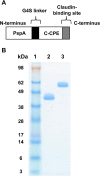C-Terminal Clostridium perfringens Enterotoxin-Mediated Antigen Delivery for Nasal Pneumococcal Vaccine
- PMID: 26018248
- PMCID: PMC4446347
- DOI: 10.1371/journal.pone.0126352
C-Terminal Clostridium perfringens Enterotoxin-Mediated Antigen Delivery for Nasal Pneumococcal Vaccine
Abstract
Efficient vaccine delivery to mucosal tissues including mucosa-associated lymphoid tissues is essential for the development of mucosal vaccine. We previously reported that claudin-4 was highly expressed on the epithelium of nasopharynx-associated lymphoid tissue (NALT) and thus claudin-4-targeting using C-terminal fragment of Clostridium perfringens enterotoxin (C-CPE) effectively delivered fused antigen to NALT and consequently induced antigen-specific immune responses. In this study, we applied the C-CPE-based vaccine delivery system to develop a nasal pneumococcal vaccine. We fused C-CPE with pneumococcal surface protein A (PspA), an important antigen for the induction of protective immunity against Streptococcus pneumoniae infection, (PspA-C-CPE). PspA-C-CPE binds to claudin-4 and thus efficiently attaches to NALT epithelium, including antigen-sampling M cells. Nasal immunization with PspA-C-CPE induced PspA-specific IgG in the serum and bronchoalveolar lavage fluid (BALF) as well as IgA in the nasal wash and BALF. These immune responses were sufficient to protect against pneumococcal infection. These results suggest that C-CPE is an efficient vaccine delivery system for the development of nasal vaccines against pneumococcal infection.
Conflict of interest statement
Figures




References
Publication types
MeSH terms
Substances
LinkOut - more resources
Full Text Sources
Other Literature Sources
Medical
Research Materials
Miscellaneous

